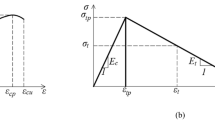Abstract
Although the great advances in concrete technology have led to the possibility of obtaining ready-mix concrete with compressive strength around 100 MPa, some national and international codes for concrete structures do not cover concrete strengths above 50 MPa. Many codes are under revision, but some of them (including the Brazilian Code) will still not include high strength concretes.
Due to the different characteristics of higher strength concrete some design procedures traditionally used in normal strength concrete structures have to be changed.
Different types of stress-train relationships for concrete have been proposed for the non-linear analysis of member behavior and for the ultimate state analysis of high strength concrete elements under combined flexure and axial load.
In this work comparisons are made between proposed stress-strain curves and between the axial load-moment interaction diagrams based on these curves. Comparisons of test results with these diagrams, for columns subjected to eccentric compression, give an idea of the different degrees of safety obtained using those curves.
Résumé
Malgré les grands progrès de la technologie en matière de béton, qui ont rendu possible l'obtention de bétons résistant à une compression d'environ 100MPa, quelques codes nationaux et internationaux relatifs aux constructions en béton ne couvrent pas des résistance du béton supérieures à 50 MPa. Plusieurs codes sont en cours de révision, mais beaucoup (dont le code brésilien) ne s'intéressent toujours pas aux bétons à haute résistance.
En raison des différentes caractéristiques des bétons à haute résistance, certains procédés de définition traditionnellement utilisés pour les constructions en béton normal doivent être modifiés.
Différents types de relations contraintes—déformations ont été proposés pour le béton dans le cadre de l'analyse non-linéaire de son comportement et dans celui de l'analyse finale des éléments en béton armé en flexion combinée avec une charge axiale.
Cet article compare les courbes contraintes—déformations proposées et les diagrammes interaction charge axiale—moment qui résultent de ces courbes. Les comparaisons effectuées entre les résultats expérimentaux et ces diagrammes, pour des colonnes soumises à des compressions excentriques viennent illuster les différents degrés de sécurité obtenus grâce à ces courbes.
Similar content being viewed by others
References
Ibrahim, H. H. H. and MacGregor, J. G., ‘Flexural behavior of laterally reinforced high-strength concrete sections’,ACI Structural Journal 93 (6) (1996) 674–684.
Comité Euro-International du Béton, ‘CEB-FIP Model Code 1990’, Bulletin d'Information no 213/214 (Laussanne, Switzerland, 1993) 437p.
Comité Euro-International du Béton, ‘High Performance Concrete’, Bulletin d'Information no 228 (Lausanne, Switzerland, 1995) 46p.
Collins, M. P., Mitchell, D. and MacGregor, J. G., ‘Structural Design Considerations for High-Strength Concrete’,Concrete International: Design and Construction 15 (5) (1993) 27–34.
Norwegian Council for Building Standardization, ‘Concrete Structures Design Rules-NS3473 E’, (Stockholm, 1992) 78p.
Brazilian Technical Standards, ‘Project and Execution of Reinforced Concrete Structures—NBR 6118’, only available in Portuguese (ABNT, Rio de Ianeiro, Brazil 1980) 76p.
Canadian Standard Association, ‘Design of Concrete Structures for Building- CAN3-A23.3-94’, Concrete Design Handbook (Canadian Portland Cement Association, Ottawa, Canada 1995).
American Concrete Institute, ‘Building Code Requirements for Structural Concrete and Commentary- ACI 318-95’, (ACI, Detroit, 1995) 369p.
Ibrahim, H. H. H. and MacGregor, J. G., ‘Modification of the ACI Rectangular Stress Block for High-Strength Concrete’,ACI Structural Journal 94 (1) (1997) 40–48.
Ibrahim,H. H. H. and MacGregor, J. G., ‘Tests of Eccentrically Loaded High-Strength Concrete Columns’,ACI Structural Journal 93 (5) (1996) 585–594.
Foster, S. J. and Attard, M. M., ‘Experimental Tests on Eccentrically Loaded High-Strength Concrete Columns’,ACI Structural Journal 94 (3) (1997) 295–303.
Author information
Authors and Affiliations
Rights and permissions
About this article
Cite this article
Shehata, I.A.E.M., Shehata, L.C.D. & Mattos, T.S. Stress-strain curve for the design of high-strength concrete elements. Mat. Struct. 33, 411–418 (2000). https://doi.org/10.1007/BF02480659
Received:
Accepted:
Issue Date:
DOI: https://doi.org/10.1007/BF02480659



